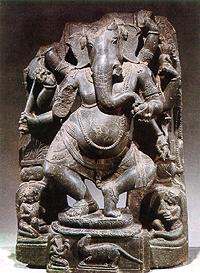GANESHA
AND HIS IDOL |
|
The writer is of the view that out of the above three sets of five heads, the interpretation regarding the set pertaining to the Koshas (sheaths) may be appropriate for Ganesha figures with five heads. The additions in features and other changes in the idols of Ganesha appear to have been necessitated by the development of Agama culture in the Hindu religion, which appealed to the imagination of the ordinary class of Hindu population. Agama sastras laid down prescriptions for the worship of idols in temples. It encouraged the instilling of a belief in the common mind that God has taken incarnation in the idol. Obviously Ganesha idols also got invested with such an incarnation idea of God acceptable to the followers of different sects in the Hindu society. The Hindu temples have now become Ganesha's strong holds from where it is difficult to dislodge him. |
 The
five heads may also mean the five Brahmas as described in the Pancha Brahmopanishad,
Shiva was credited with these heads, viz., (1) Sadyojatha (2) Aghora (3)
Vama Deva (4) Tat Purusha (5) Isana. When Ganesha became more powerful
than Shiva his devotees may have invested him with these five heads. This
is only speculation.
The
five heads may also mean the five Brahmas as described in the Pancha Brahmopanishad,
Shiva was credited with these heads, viz., (1) Sadyojatha (2) Aghora (3)
Vama Deva (4) Tat Purusha (5) Isana. When Ganesha became more powerful
than Shiva his devotees may have invested him with these five heads. This
is only speculation.